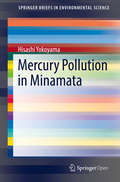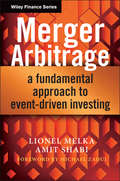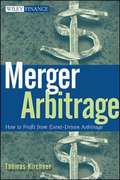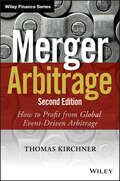- Table View
- List View
Merck & Co.: Evaluating a Drug Licensing Opportunity
by David Krieger Richard S. RubackThis explores the valuation of an opportunity to license a compound before it enters clinical trials. Describes Merck's decision tree evaluation process is presented. Information required to evaluate a specific licensing opportunity is provided, including the costs of the three phases of the review process, the revenues if approved, and the probability of various outcomes. It includes an introduction to decision tree analysis and valuation.
Merck Global Health Initiatives (A)
by James Weber James E. Austin Diana BarrettThe case series focuses on Merck's drug donation program and then raises new issues facing management about what to do about HIV/AIDS in Africa given the company's development of a new therapy. Describes collaboration among many parties including the Gates Foundation, other pharmaceutical companies, and the government of Botswana.
Merck Sharp & Dohme Argentina, Inc. (A)
by Lynn Sharp Paine Harold F. Hogan Jr.Describes the efforts of the new managing director of Merck's subsidiary for Argentina, Uruguay, and Paraguay to transform the organization and its culture. Focuses on a critical decision: whether to offer the son of a high-ranking official in the government's national health-care program a place in the company's highly selective intern program for young professionals.
Merck Sharp & Dohme Argentina, Inc. (B)
by Lynn Sharp Paine Harold F. Hogan Jr.Supplements the (A) case.
Merck-Medco: Vertical Integration in the Pharmaceutical Industry
by V. Kasturi Rangan Marie BellRecords the analyses and actions taken by Merck Pharmaceuticals in its acquisition of Medco, a channel intermediary (called "pharmacy benefit manager"). While many of its competitors seem to be faring poorly, Merck seems to have managed the Medco integration superbly.
Merck: Conflict and Change
by Clark Gilbert Ratna SarkarTracks Merck's efforts to adapt to changes in the pharmaceutical industry. Key challenges include adapting Merck's internally focused, science-led culture to a more open environment, where marketing performance has become increasingly important. Examines Merck's efforts to adapt to the external changes without compromising its internal values and capability architecture.
Merck: Covid-19 Vaccines
by Willy ShihCovid-19 infections were still climbing across the U.S. and many other parts of the world in September 2020, and it seemed that every time Ken Frazier, the CEO of Merck & Co. consented to an interview in recent months he always seemed to hear the same question, "Where's Merck?" The company, a leader in the global vaccine business had a low public profile even though it was working assiduously on two vaccine candidates for the SARS-CoV-2 virus that causes Covid-19. The U.S. Government had initiated a high profile program - Operation Warp Speed (OWS) - to accelerate the development of vaccines, but Merck was notably absent. Should Merck seek or accept funding from OWS, and what terms might accompany such an agreement?
Merck: Global Health and Access to Medicines
by V. Kasturi Rangan Katharine LeeThe case describes the effort of Merck, a global leader in pharmaceuticals, in making available its medicines to the poor. The challenge for the company (or for that matter, any pharmaceutical company) is how to integrate its business strategy with its corporate social responsibility, especially when operating in "lower income" countries.
Merck: Global Health and Access to Medicines
by V. Kasturi Rangan Katharine LeeThe case describes the effort of Merck, a global leader in pharmaceuticals, in making available its medicines to the poor. The challenge for the company (or for that matter, any pharmaceutical company) is how to integrate its business strategy with its corporate social responsibility, especially when operating in "lower income" countries.
Merck: Managing Vioxx (A)
by Natalie Kindred Robert L. Simons Kathryn RosenbergThis two-class case series allows students to stand in the shoes of CEO Ray Gilmartin during the unfolding stages of a reputational crisis. Merck's mission statement claims to "put patients first," but the company is widely criticized for putting profit before patient safety. The (A) case describes the discovery of Vioxx, a new arthritis drug, and asks students to calculate the drug's lifetime expected value. Supplements are handed out in class as the story unfolds: (B) evidence of life-threatening side effects, (C) decision options, (D) announcement to withdraw Vioxx, (E) reaction by patients, shareholders, media, and regulators, (F) Merck fights back, and (G) wrap-up. At the end of the case series, students may conclude that doing the right thing sometimes requires very hard choices.
Mercury Athletic: Valuing the Opportunity
by Timothy A. Luehrman Joel L. HeilprinIn January 2007, West Coast Fashions, Inc., a large designer and marketer of branded apparel, announced a strategic reorganization that would result in the divestiture of their wholly owned footwear subsidiary, Mercury Athletic. John Liedtke, the head of business development for Active Gear, a mid-sized athletic and casual footwear company, saw the potential acquisition of Mercury as a unique opportunity to roughly double the size of his business. The case uses the potential acquisition of Mercury Athletic as a vehicle to teach students basic DCF (discounted cash flow) valuation using the weighted average cost of capital (WACC).
Mercury Pollution in Minamata (SpringerBriefs in Environmental Science)
by Hisashi YokoyamaThis book is open access under a CC BY 4.0 license. It overviews the poisoning which occurred in the 1950s and 1960s among the residents in Minamata who ate seafood contaminated with methylmercury discharged from the chemical factory, Chisso Corporation. It describes the history, symptoms pathogenesis and research on the causal agent, and discusses the responses of Chisso and the national and local governments to the outbreak, the victims, the compensation and environmental restructuring as well as the court ruling on claims. Based on lecture notes from a university course, it includes students’ suggestions for avoiding a repeat of the tragedy. The issue has not been settled yet, and this analysis of the incident provides useful insights into solutions to the current global mercury pollution problem.
Mercury Rising: Knight Ridder's Digital Venture
by Clark GilbertCaptures the efforts of newspaper publisher Knight Ridder to create a digital venture. Knight Ridder proves to be a pioneer in digital publishing, launching the first online newspaper site; builds a network of newspaper sites called Real Cities; and invests in Careerbuilder, the second largest career site after Monster.com. However, the company has cumulatively lost over $100 million in its core Internet operations, is missing important categories of advertising revenue, and is operating in an ad recession at the time of the case. Tracks the evolution of the venture that spans nearly a decade and can be summarized in three distinct periods: 1) initial launch and experimentation, 2) rapid expansion within the newspaper organization vs. operation as a separate venture, and 3) managing the venture after the Internet bubble has burst.
Mercy Corps: Global Social Entrepreneurship (A)
by Christopher A. Bartlett Daniel F. CurranNeal Keny-Guyer, CEO of Mercy Corps International, built his organization by following the advice of Theodore Roosevelt: "Be smart enough to hire good people and have sense enough to get out of their way." For eight years, Keny-Guyer helped Mercy Corps grow in size and scope and by 2001, delivered $117 million in social programs to people in over 30 countries. Convinced that much of that success had come from empowering front-line managers to lead the agency by pursuing opportunities in the field, he wanted to continue the approach. But, recent experiences in Afghanistan had exposed some weaknesses in Mercy Corps' ability to maintain an entrepreneurial approach in an emergency situation. What had worked so well in an organization of 200 was encountering difficulties now that worldwide staff exceeded 2,000. At a global leadership conference in late October 2002, Keny-Guyer met with his senior leadership team. In addition to wrestling with the political complexities of working in Iraq, he wanted to get their input on how Mercy Corps should respond if they decided it was the right course of action.
Mercy Corps: Positioning the Organization to Reach New Heights
by Caroline King Allen GrossmanMercury Corps, the world's 5th largest international relief and development agency, is at a turning point. The nonprofit's opportunities to grow and serve a larger number of beneficiaries are unprecedented. By looking at the unique relationship between headquarters and over 40 country offices, explores the question--is Mercury Corps well positioned to effectively and efficiently manage these new growth opportunities.
Mercy For Animals: One Man's Quest to Inspire Compassion and Improve the Lives of Farm Animals
by Gene Stone Nathan RunkleA compelling look at animal welfare and factory farming in the United States from Mercy For Animals, the leading international force in preventing cruelty to farmed animals and promoting compassionate food choices and policies. Nathan Runkle would have been a fifth-generation farmer in his small midwestern town. Instead, he founded our nation’s leading nonprofit organization for protecting factory farmed animals. In Mercy For Animals, Nathan brings us into the trenches of his organization’s work; from MFA’s early days in grassroots activism, to dangerous and dramatic experiences doing undercover investigations, to the organization’s current large-scale efforts at making sweeping legislative change to protect factory farmed animals and encourage compassionate food choices.But this isn’t just Nathan’s story. Mercy For Animals examines how our country moved from a network of small, local farms with more than 50 percent of Americans involved in agriculture to a massive coast-to-coast industrial complex controlled by a mere 1 percent of our population—and the consequences of this drastic change on animals as well as our global and local environments. We also learn how MFA strives to protect farmed animals in behind-the-scenes negotiations with companies like Nestlé and other brand names—conglomerates whose policy changes can save countless lives and strengthen our planet. Alongside this unflinching snapshot of our current food system, readers are also offered hope and solutions—big and small—for ending mistreatment of factory farmed animals. From simple diet modifications to a clear explanation of how to contact corporations and legislators efficiently, Mercy For Animals proves that you don’t have to be a hardcore vegan or an animal-rights activist to make a powerful difference in the lives of animals.
Merger Arbitrage
by Lionel Melka Amit ShabiA wave of corporate mergers, acquisitions, restructuring, and similar transactions has created unprecedented opportunities for those versed in contemporary risk arbitrage techniques. At the same time, the nature of the merger wave has lent such transactions a much higher degree of predictability than ever before, making risk arbitrage more attractive to investors. Surprisingly, there is little transparency and instruction for investors interested in learning the latest risk arbitrage techniques. Merger Arbitrage - A Fundamental Approach to Event-Driven Investing helps readers understand the inner workings of the strategy and hedge funds which engaged in this investment strategy.Merger arbitrage is one of the most commonly used strategies but paradoxically one of the least known. This book puts it in the spotlight and explains how fund managers are able to benefit from mergers and acquisitions. It describes how to implement this strategy, located at the crossroad of corporate finance and asset management, and where its risks lie through numerous topical examples.The book is split into three parts. The first part, examining the basis of merger arbitrage, looks at the key role of the market in takeover bids. It also assesses the major changes in the financial markets over recent years and their impact on M&A. Various M&A risk and return factors are also discussed, alongside the historical profitability of merger arbitrage, the different approaches used by fund managers and the results of academic studies on the subject. The second part of the book deals with the risk of an M&A transaction failing in terms of financing risk, competition issues, the legal aspects of merger agreements and administrative and political risks. The third part of the book examines specificities of M&A transactions, comprehensively covering hostile takeovers and leveraged buyouts. Each part contains many recent examples and case studies in order to show how the various theories and notions are put into practice.From researching prospects and determining positions, to hedging and trading tactics, Lionel Melka and Amit Shabi present the full complement of sophisticated risk arbitrage techniques, making Merger Arbitrage a must read for finance and investment professionals who want to take advantage of the nearly limitless opportunities afforded by today's rapidly changing global business environment. The book builds on its authors' diverse backgrounds and common experience managing a merger arbitrage fund, providing readers with an enriching inside view on M&A operations.
Merger Arbitrage
by Thomas KirchnerA detailed look at an important hedge fund strategy Written by a fund manager who invests solely in merger arbitrage, also referred to as risk arbitrage, and other event-driven strategies, Merger Arbitrage is the definitive book on how this alternative hedge fund strategy works. Initial chapters are dedicated to the ins and outs of the strategy-cash mergers versus stock for stock mergers, legal aspects of mergers, and pitfalls of the merger process-while later chapters focus on giving the reader sound advice for integrating merger arbitrage into an investment portfolio. Merger Arbitrage helps readers understand leverage and options, shorting stocks, and legal aspects of merger arbitrage, including seeking appraisal or filing lawsuits for inadequate merger consideration. For those looking to gain an edge in the merger arbitrage arena, this book has everything they need to succeed. Thomas F. Kirchner, CFA (New York, NY), is the founder and portfolio manager of Pennsylvania Avenue Funds (www. pennavefunds. com), which invests in merger arbitrage and other event-driven strategies.
Merger Arbitrage: How to Profit from Global Event-Driven Arbitrage
by Thomas KirchnerMitigate risk and increase returns with an alternative hedge fund strategy Merger Arbitrage: How to Profit from Event-Driven Arbitrage, Second Edition is the definitive guide to the ins and outs of the burgeoning merger arbitrage hedge fund strategy, with real-world examples that illustrate how mergers work and how to take advantage of them. Author Thomas Kirchner, founder of the Pennsylvania Avenue Event-Driven Fund, discusses the factors that drove him to invest solely in merger arbitrage and other event-driven strategies, and details the methods used to incorporate merger arbitrage into traditional investment strategies. And while there is always a risk that a deal will fall through, the book explains how minimal such risks really are when the potential upside is factored in. Early chapters of the book focus on the basics of the merger arbitrage strategy, including an examination of mergers and the incorporation of risk into the arbitrage decision. Following chapters detail deal structures, financing, and legal aspects to provide the type of in-depth knowledge required to execute an effective investment strategy. The updated second edition stresses new, increasingly relevant information like: Worldwide legal deal regimes UK takeover code UK takeover code global offspring Regulators around the world The book provides clear, concise guidance on critical considerations including leverage and options, shorting stocks, and legal recourse for inadequate merger consideration, allowing readers to feel confident about trying a new investment strategy. With simple benefits including diversification of risk and return streams, this alternative hedge fund strategy has a place in even the most traditional plan. Merger Arbitrage: How to Profit from Event-Driven Arbitrage, Second Edition provides the information that gives investors an edge in the merger arbitrage arena.





